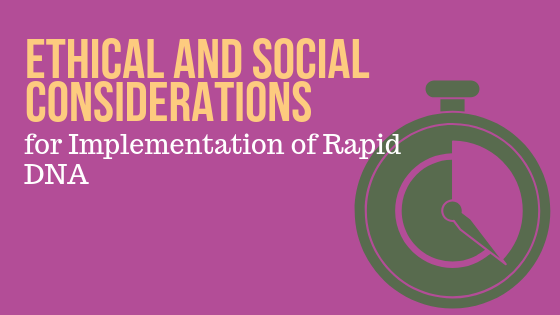Rapid DNA has been under development for over a decade, but now it is beginning to be implemented in law enforcement and, potentially, other contexts. The new technology is a boon to quick, efficient processing of DNA, but its broad use could pose some ethical questions. Traditional DNA analysis already comes with questions of privacy and scope of surveillance; rapid DNA not only amplifies these concerns, but introduces new considerations as well.
Written by: Diana Madden, Duke Initiative for Science & SOciety
As guidelines are being developed following the passage of the Rapid DNA Act of 2017, we hope to see consideration of the social and ethical implications of this new technology. The best way to assess the potential issues for such guidelines would be to consult with a number of stakeholders to deliberate the pros and cons of approaches. But thus far, more than a year since the Act was signed into law, this initiative has not been taken.
We at Duke sought to kick-start the effort by identifying the key ethical and social issues surrounding rapid DNA. The Principal Investigator (Sara Katsanis) approached the Director of the Duke University Summer Science Policy Institute (Alexa Sutton Lawrence), who in turn recruited two fellows in the Summer Institute (me, Diana Madden, and my partner, Fahiima Mohamed) to take on the challenge. Over the summer, the three of us dove into background readings across disciplines, tracked rapid DNA-related media and legislation, and identified key questions that we thought could prompt experts to define the issues that should be addressed in guidelines for rapid DNA implementation. We pre-identified three contexts ((1) for criminal justice; (2) for disaster victim identification and missing persons; and (3) for immigration) in which rapid DNA might be used in the near future. Then we reached out to four key informants (two representing humanitarian and civil liberties organizations and two forensics experts in law enforcement and missing persons) to gather their input and thoughts on rapid DNA applications.
These informal interviews resulted in a set of potential implementation challenges, considerations, and suggestions, all specific to rapid DNA and all proposed by the key informants (not the authors). Some are practical, some legal, and all examine the ethical boundaries of implementing this technology. We compiled all of these thoughts and grouped them into three broad categories: (a) data collection, (b) data access and storage, and (c) oversight and data protection. The result is a catalogue of considerations for the implementation of rapid DNA in various contexts (expanded from three to eight), presented in a poster at the ISHI29 conference.
While this catalogue is the central contribution of our poster, our readings and discussions also led us to think deeply about rapid DNA technologies. We realized the importance of considering the second-order effects of rapid DNA based on the purpose and context of testing in order to ensure that it contributes to the public good. We also realized the need to both recognize the unique challenges introduced by rapid DNA and to draw on discussion of pre-existing challenges with traditional forensic DNA analysis in general.
Finally, we watched our list of stakeholders grow to encompass law enforcement, other federal authorities, oversight organizations, vendors and users, non-governmental organizations, humanitarian and civil-liberties advocates, policy makers, and the public. Our conversations with just four stakeholders revealed the variety of experiences, skill sets, and perspectives they brought to the issue. They agreed on some points, but differed on others, indicating the need, moving forward, for diverse stakeholders to be consulted in the creation of guidelines, perhaps through a working group or consultation with a third-party organization to research approaches.
Ultimately, our poster is both an initial contribution to this ongoing conversation and a model of how we hope guidelines will continue to develop: with attention to social and ethical parameters and the input of a diverse range of stakeholders.
WOULD YOU LIKE TO SEE MORE ARTICLES LIKE THIS? SUBSCRIBE TO THE ISHI BLOG BELOW!


